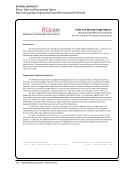SPEC Kit 329: Managing Born-Digital Special Collections and Archival Materials · 11
Executive Summary
Introduction
The 2010 OCLC Research report, Taking Our Pulse, list-
ed management of born-digital materials as the third
biggest challenge facing libraries, special collections,
and archives, after space and facilities. It has become
a truism that the trickle of born-digital materials into
special collections has become a flood. Increasingly,
these materials do not have analog counterparts.
Libraries and archives can no longer defer decisions
about digital content to a later date. We must develop
policies and procedures to operationalize the manage-
ment of born-digital materials, or we risk losing the
record of the recent past.
This survey sought to gather and promote emerg-
ing good practices for managing born-digital content
and to highlight common challenges. The survey in-
strument focused in particular on staffing, ingest and
processing workflows, storage procedures, and access
and discovery methods. Sixty-four of the 126 ARL
member libraries responded to the survey between
February 22 and March 23 for a response rate of 51%.
Fifty-nine of the respondents (92%) already collect
born-digital content. The remaining five libraries are
in the planning stages. The level of engagement with
born-digital content was higher than anticipated by
the survey team. An analysis of the responding librar-
ies engaged with born-digital materials revealed they
are larger institutions and therefore more likely to be
pioneers in working with this content.
The management of born-digital materials is still
relatively new for ARL libraries, and the survey re-
sults show that good practices and workflows are
still evolving. New tools are emerging rapidly, and
the once-solid line between digitized content and
born-digital content is beginning to blur. Survey re-
sponses indicated that the library and archives pro-
fession lacks a common definition of what born-dig-
ital content is and a common understanding of who
within the organization should manage this content.
Staffing and Organization
The survey asked how many library staff collect and
manage born-digital materials, who has responsibility
for storage-related activities, how staffing needs are
addressed, and how staff gain the expertise required
to manage these materials. No one staffing or organi-
zational structure emerged from the survey responses,
which again reflects the evolutionary status of born-
digital management programs.
The number of staff working with born-digital
archival content in the responding libraries ranges
from less than one to 60 FTE. While archivists and
librarians in institutional and government archives
were the trailblazers in collecting this content, man-
aging these materials now requires staff from digi-
tization, digital curation, information technology,
and institutional repository units. Respondents most
frequently mentioned special collections/archives
staff and library IT staff as having decision-making
responsibility for selecting storage solutions, imple-
menting and maintaining infrastructure, managing
user authentication, estimating storage needs and
monitoring usage, and budgeting. Many other units
are also involved, including institutional IT, preserva-
tion, collections, administration, and consortia in a
wide variety of combinations.
This organizational distribution may factor into
how respondents have addressed staffing needs for
Executive Summary
Introduction
The 2010 OCLC Research report, Taking Our Pulse, list-
ed management of born-digital materials as the third
biggest challenge facing libraries, special collections,
and archives, after space and facilities. It has become
a truism that the trickle of born-digital materials into
special collections has become a flood. Increasingly,
these materials do not have analog counterparts.
Libraries and archives can no longer defer decisions
about digital content to a later date. We must develop
policies and procedures to operationalize the manage-
ment of born-digital materials, or we risk losing the
record of the recent past.
This survey sought to gather and promote emerg-
ing good practices for managing born-digital content
and to highlight common challenges. The survey in-
strument focused in particular on staffing, ingest and
processing workflows, storage procedures, and access
and discovery methods. Sixty-four of the 126 ARL
member libraries responded to the survey between
February 22 and March 23 for a response rate of 51%.
Fifty-nine of the respondents (92%) already collect
born-digital content. The remaining five libraries are
in the planning stages. The level of engagement with
born-digital content was higher than anticipated by
the survey team. An analysis of the responding librar-
ies engaged with born-digital materials revealed they
are larger institutions and therefore more likely to be
pioneers in working with this content.
The management of born-digital materials is still
relatively new for ARL libraries, and the survey re-
sults show that good practices and workflows are
still evolving. New tools are emerging rapidly, and
the once-solid line between digitized content and
born-digital content is beginning to blur. Survey re-
sponses indicated that the library and archives pro-
fession lacks a common definition of what born-dig-
ital content is and a common understanding of who
within the organization should manage this content.
Staffing and Organization
The survey asked how many library staff collect and
manage born-digital materials, who has responsibility
for storage-related activities, how staffing needs are
addressed, and how staff gain the expertise required
to manage these materials. No one staffing or organi-
zational structure emerged from the survey responses,
which again reflects the evolutionary status of born-
digital management programs.
The number of staff working with born-digital
archival content in the responding libraries ranges
from less than one to 60 FTE. While archivists and
librarians in institutional and government archives
were the trailblazers in collecting this content, man-
aging these materials now requires staff from digi-
tization, digital curation, information technology,
and institutional repository units. Respondents most
frequently mentioned special collections/archives
staff and library IT staff as having decision-making
responsibility for selecting storage solutions, imple-
menting and maintaining infrastructure, managing
user authentication, estimating storage needs and
monitoring usage, and budgeting. Many other units
are also involved, including institutional IT, preserva-
tion, collections, administration, and consortia in a
wide variety of combinations.
This organizational distribution may factor into
how respondents have addressed staffing needs for










































































































































































































